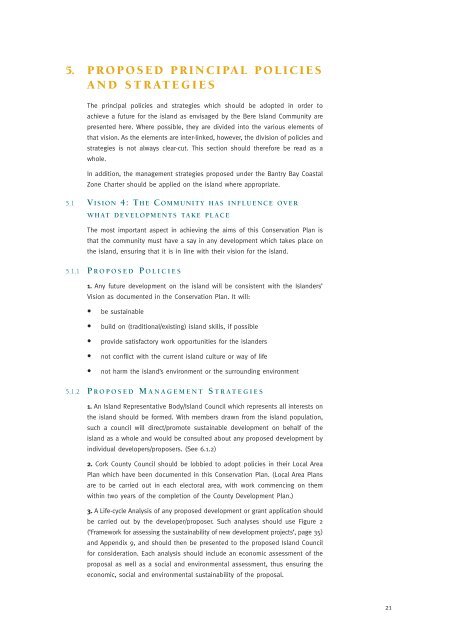Bere Island Conservation Plan - The Heritage Council
Bere Island Conservation Plan - The Heritage Council
Bere Island Conservation Plan - The Heritage Council
You also want an ePaper? Increase the reach of your titles
YUMPU automatically turns print PDFs into web optimized ePapers that Google loves.
5. PROPOSED PRINCIPAL POLICIES<br />
AND STRATEGIES<br />
<strong>The</strong> principal policies and strategies which should be adopted in order to<br />
achieve a future for the island as envisaged by the <strong>Bere</strong> <strong>Island</strong> Community are<br />
presented here. Where possible, they are divided into the various elements of<br />
that vision. As the elements are inter-linked, however, the division of policies and<br />
strategies is not always clear-cut. This section should therefore be read as a<br />
whole.<br />
In addition, the management strategies proposed under the Bantry Bay Coastal<br />
Zone Charter should be applied on the island where appropriate.<br />
5.1 VISION 4: THE COMMUNITY HAS INFLUENCE OVER<br />
WHAT DEVELOPMENTS TAKE PLACE<br />
<strong>The</strong> most important aspect in achieving the aims of this <strong>Conservation</strong> <strong>Plan</strong> is<br />
that the community must have a say in any development which takes place on<br />
the island, ensuring that it is in line with their vision for the island.<br />
5.1.1 P ROPOSED P OLICIES<br />
1. Any future development on the island will be consistent with the <strong>Island</strong>ers’<br />
Vision as documented in the <strong>Conservation</strong> <strong>Plan</strong>. It will:<br />
• be sustainable<br />
• build on (traditional/existing) island skills, if possible<br />
• provide satisfactory work opportunities for the islanders<br />
• not conflict with the current island culture or way of life<br />
• not harm the island’s environment or the surrounding environment<br />
5.1.2 P ROPOSED M ANAGEMENT S TRATEGIES<br />
1. An <strong>Island</strong> Representative Body/<strong>Island</strong> <strong>Council</strong> which represents all interests on<br />
the island should be formed. With members drawn from the island population,<br />
such a council will direct/promote sustainable development on behalf of the<br />
island as a whole and would be consulted about any proposed development by<br />
individual developers/proposers. (See 6.1.2)<br />
2. Cork County <strong>Council</strong> should be lobbied to adopt policies in their Local Area<br />
<strong>Plan</strong> which have been documented in this <strong>Conservation</strong> <strong>Plan</strong>. (Local Area <strong>Plan</strong>s<br />
are to be carried out in each electoral area, with work commencing on them<br />
within two years of the completion of the County Development <strong>Plan</strong>.)<br />
3. A Life-cycle Analysis of any proposed development or grant application should<br />
be carried out by the developer/proposer. Such analyses should use Figure 2<br />
(‘Framework for assessing the sustainability of new development projects’, page 35)<br />
and Appendix 9, and should then be presented to the proposed <strong>Island</strong> <strong>Council</strong><br />
for consideration. Each analysis should include an economic assessment of the<br />
proposal as well as a social and environmental assessment, thus ensuring the<br />
economic, social and environmental sustainability of the proposal.<br />
21

















